Related Research Articles

A savanna or savannah is a mixed woodland-grassland ecosystem characterised by the trees being sufficiently widely spaced so that the canopy does not close. The open canopy allows sufficient light to reach the ground to support an unbroken herbaceous layer consisting primarily of grasses. According to Britannica, there exists four savanna forms; savanna woodland where trees and shrubs form a light canopy, tree savanna with scattered trees and shrubs, shrub savanna with distributed shrubs, and grass savanna where trees and shrubs are mostly nonexistent.

Bromus tectorum, known as downy brome, drooping brome or cheatgrass, is a winter annual grass native to Europe, southwestern Asia, and northern Africa, but has become invasive in many other areas. It now is present in most of Europe, southern Russia, Japan, South Africa, Australia, New Zealand, Iceland, Greenland, North America and western Central Asia. In the eastern US B. tectorum is common along roadsides and as a crop weed, but usually does not dominate an ecosystem. It has become a dominant species in the Intermountain West and parts of Canada, and displays especially invasive behavior in the sagebrush steppe ecosystems where it has been listed as noxious weed. B. tectorum often enters the site in an area that has been disturbed, and then quickly expands into the surrounding area through its rapid growth and prolific seed production.
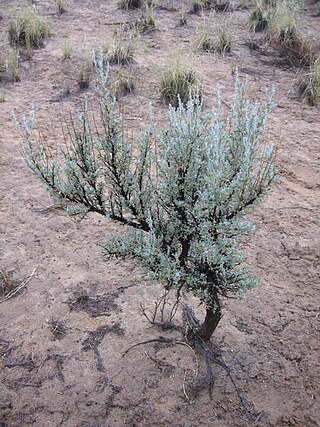
Artemisia tridentata, commonly called big sagebrush, Great Basin sagebrush or (locally) simply sagebrush, is an aromatic shrub from the family Asteraceae, which grows in arid and semi-arid conditions, throughout a range of cold desert, steppe, and mountain habitats in the Intermountain West of North America. The vernacular name "sagebrush" is also used for several related members of the genus Artemisia, such as California sagebrush.
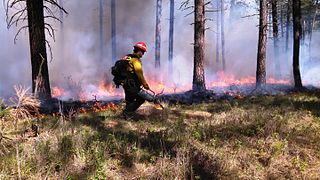
A controlled or prescribed burn, also known as hazard reduction burning, backfire, swailing, or a burn-off, is a fire set intentionally for purposes of forest management, fire suppression, farming, prairie restoration or greenhouse gas abatement. A controlled burn may also refer to the intentional burning of slash and fuels through burn piles. Fire is a natural part of both forest and grassland ecology and controlled fire can be a tool for foresters.

Rangelands are grasslands, shrublands, woodlands, wetlands, and deserts that are grazed by domestic livestock or wild animals. Types of rangelands include tallgrass and shortgrass prairies, desert grasslands and shrublands, woodlands, savannas, chaparrals, steppes, and tundras. Rangelands do not include forests lacking grazable understory vegetation, barren desert, farmland, or land covered by solid rock, concrete and/or glaciers.
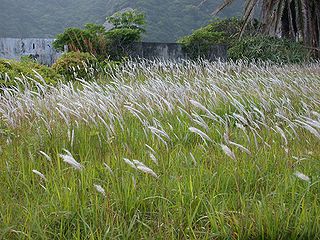
Imperata cylindrica is a species of perennial rhizomatous grass native to tropical and subtropical Asia, Micronesia, Melanesia, Australia, Africa, and Southern Europe. It has also been introduced to Latin America, the Caribbean, and the Southeastern United States. It is a highly flammable pyrophyte, and can spread rapidly by colonizing disturbed areas and encouraging more frequent wildfires.

Fire ecology is a scientific discipline concerned with natural processes involving fire in an ecosystem and the ecological effects, the interactions between fire and the abiotic and biotic components of an ecosystem, and the role as an ecosystem process. Many ecosystems, particularly prairie, savanna, chaparral and coniferous forests, have evolved with fire as an essential contributor to habitat vitality and renewal. Many plant species in fire-affected environments use fire to germinate, establish, or to reproduce. Wildfire suppression not only endangers these species, but also the animals that depend upon them.

Sagebrush steppe is a type of shrub-steppe, a plant community characterized by the presence of shrubs, and usually dominated by sagebrush, any of several species in the genus Artemisia. This ecosystem is found in the Intermountain West in the United States.

Burned area emergency response (BAER) is an emergency risk management reaction to post wildfire conditions that pose risks to human life and property or could further destabilize or degrade the burned lands. Even though wildfires are natural events, the presence of people and man-made structures in and adjacent to the burned area frequently requires continued emergency risk management actions. High severity wildfires pose a continuing flood, debris flow and mudflow risk to people living within and downstream from a burned watershed as well as a potential loss of desirable watershed values.
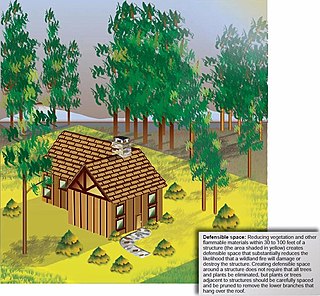
A defensible space, in the context of fire control, is a natural and/or landscaped area around a structure that has been maintained and designed to reduce fire danger. The practice is sometimes called firescaping. "Defensible space" is also used in the context of wildfires, especially in the wildland-urban interface (WUI). This defensible space reduces the risk that fire will spread from one area to another, or to a structure, and provides firefighters access and a safer area from which to defend a threatened area. Firefighters sometimes do not attempt to protect structures without adequate defensible space, as it is less safe and less likely to succeed.

Neyraudia reynaudiana, commonly known as Burma reed, silk reed, cane grass, or false reed, is a tall, perennial, large-plumed grass native to subtropical Asia, but invasive in southern Florida in the United States.
A fire regime is the pattern, frequency, and intensity of the bushfires and wildfires that prevail in an area over long periods of time. It is an integral part of fire ecology, and renewal for certain types of ecosystems. A fire regime describes the spatial and temporal patterns and ecosystem impacts of fire on the landscape, and provides an integrative approach to identifying the impacts of fire at an ecosystem or landscape level. If fires are too frequent, plants may be killed before they have matured, or before they have set sufficient seed to ensure population recovery. If fires are too infrequent, plants may mature, senesce, and die without ever releasing their seed.

Taeniatherum is a genus of Eurasian and North African plants in the grass family.
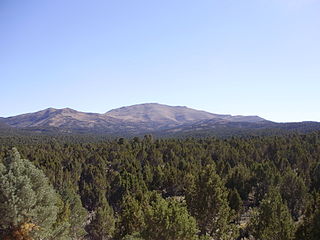
Pinyon–juniper woodland, also spelled piñon–juniper woodland, is a vegetation type (biome) of Western United States higher elevation deserts, characterized by being an open forest dominated by low, bushy, evergreen junipers, pinyon pines, and their associates which vary from region to region. The woodland's density and crown height varies dramatically depending on the site's soil and climate, the age of the stand, and the particular species present, with mature trees ranging in height from as low as 2 meters up to 15 meters. At lower elevations, junipers often predominate and trees are spaced widely, bordering on and mingling with grassland or shrubland. As elevation increases, pinyon pines become common and trees grow closer, forming denser canopies. Historically, pinyon-juniper woodland has provided a vital source of fuel and food for peoples of the American Southwest.

Artemisia filifolia, known by common names including sand sagebrush, sand sage and sandhill sage, is a species of flowering plant in the aster family. It is native to North America, where it occurs from Nevada east to South Dakota and from there south to Arizona, Chihuahua, and Texas.

Forestry mulching is a land clearing method that uses a single machine to cut, grind, and clear vegetation.
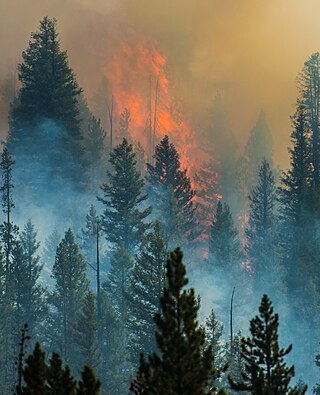
The Beaver Creek Fire was a forest fire that began on August 7, 2013 after a lightning strike in an area twelve miles northeast of Fairfield, Idaho and northwest of Hailey, Idaho in Sawtooth National Forest. The fire burned through pine trees, sagebrush, timber in the understory, grass, and various riparian areas. The fire coated the resort areas of Hailey, Ketchum, and Sun Valley, in a layer of thick soot and ash. By the time the fire was fully contained on August 31, 114,900 acres of the Ketchum Ranger District of Sawtooth National Forest has been burned. Of the 114,900 acres burned, 57,000 acres were moderately damaged and 9,500 acres were severely damaged.
The Sagebrush Sea, also called the sagebrush steppe, is an ecosystem of the Great Basin that is primarily centered on the 27 species of sagebrush that grow from sea level to about 12,000 feet. This ecosystem is home to hundreds of species of both fauna and flora. It includes small mammals such as pygmy rabbits, reptiles such as the sagebrush lizard, birds such as the golden eagles, and countless other species that are solely found in this ecosystem. This ecosystem at one point occupied over 62 million hectares in the western United States and southwestern Canada. It currently only occupies about 56 percent of historic range and is continuing to decline due to several factors.
Post-fire hillslope stabilization treatments are treatments aimed at stabilizing fire-affected slopes by counteracting the negative impact of fire on vegetation and soil properties. The final objective of these treatments is reducing the risk of catastrophic runoff and erosion events and protecting valued resources downhill. Post-fire hillslope stabilization treatments are also called post-fire mitigation treatments and emergency stabilization treatments.
Roger Dale Rosentreter is a botanist, plant ecologist, naturalist, and conservationist. He was the president of the American Bryological and Lichenological Society from 2011 to 2013.
References
- ↑ Pyne, S.J. Fire in America. 1982. A Cultural History of Wildland and Rural Fire. Princeton University Press. 654 p. ISBN 0-295-97592-X
- ↑ Moody, J.A. and D.A. Martin. 2001. Post-fire, rainfall intensity-peak discharge relations for three mountainous watersheds in the western USA. Hydrological Processes, 15(15):2981-2993
- ↑ Pietraszek, J.H. 2006. Controls on post-fire erosion at the hillslope scale, Colorado, M.S. Thesis. Colorado State Univ. Ft. Collins Co. 124p.
- ↑ Beyers, J. L. 2004. Postfire seeding for erosion control: effectiveness and impacts on native plant communities. Conservation Biology 18(4):947-956.
- ↑ Waggenbrenner, J.W. 2003. Effectiveness of burned area emergency rehabilitation treatments, Colorado Front Range. M.S. Thesis, Department of Earth Resources, Colorado State University, Fort Collins, CO.
- ↑ Robichaud, P.R. and W.J.Elliot. 2006. Protection from erosion following wildfire. Written for presentation at the 2006 ASABE Annual International Meeting. Sponsored by ASABE, Portland Convention Center, Portland, OR. 9–12 July 2006. ASABE Paper No. 068009. American Society of Agricultural and Biological Engineers.
- ↑ Robichaud, P.R., T.R. Lillybridge, and J.W. Wagenbrenner. 2006. Effects of post fire seeding and fertilizing on hillslope erosion in northern-central Washington, Catena 67(1):56-67.
- ↑ Thompson, T.W., B.A. Roundy, E.D. McArthur, B. D. Jessop, B. Waldron, and J.N. Davis. 2006. Fire Rehabilitation Using Native and Introduced Species: A Landscape Trial. Rangeland Ecol. Manage. 59:237-248.
- ↑ Evans, J.R., and M.P. Lih. 2005. Recovery and rehabilitation of vegetation on the Fitzner-Eberhardt Arid Lands Ecology Reserve, Hanford Reach National Monument, following the 24 Command Fire. The Nature Conservancy of Washington, 217 Pine St. Suite 1100, Seattle, Wa. 246p.
- ↑ Floyd, M.L., D. Hanna, W.R.Romme, and T.E. Crews. 2006. Predicting and mitigating weed invasion to restore natural post-fire succession in Mesa Verde National Park, Colorado, USA. International Journal of Wildland Fire 15:247-259.
- ↑ Eiswerth, M.E. and J.S. Shonkwiler. 2006. Examining post-wildfire reseeding on arid rangeland: a multivariate tobit modeling approach. Ecological Modelling 192:286-298.
- ↑ Hunter M.E., P.N. Omi, E.J. Martinson and G.W. Chong. 2006. Establishment of non-native plant species after wildfires: effects of fuel treatment, abiotic and biotic factors, and post-fire grass seeding treatments. International Journal of Wildland Fire 15:771-281.
- ↑ Thompson, T.W., B.A. Roundy, E.D. McArthur, B. D. Jessop, B. Waldron, and J.N. Davis. 2006. Fire Rehabilitation Using Native and Introduced Species: A Landscape Trial. Rangeland Ecol. Manage. 59:237-248
- ↑ Seabloom, E.W., W.S. Harpole, O.J. Reichman and D. Tilman. 2003. Invasion, competitive dominance, and resource use by exotic and native California grassland species. PNAS 100(23)13384-13389
- ↑ Leger E.A. 2005. The adaptive value of remnant native plants in invaded communities: an example from the Great Basin. Ecological Applications 8(5):1226–1235
- ↑ Hunter M.E., P.N. Omi, E.J. Martinson and G.W. Chong. 2006. Establishment of non-native plant species after wildfires: effects of fuel treatment, abiotic and biotic factors, and post-fire grass seeding treatments. International Journal of Wildland Fire 15:771-281.
- ↑ Beyers, J. L. 2004. Postfire seeding for erosion control: effectiveness and impacts on native plant communities. Conservation Biology 18(4):947-956.
- ↑ Hunter M.E., P.N. Omi, E.J. Martinson and G.W. Chong. 2006. Establishment of non-native plant species after wildfires: effects of fuel treatment, abiotic and biotic factors, and post-fire grass seeding treatments. International Journal of Wildland Fire 15:771-281.
- ↑ Keeley, J.E. 2004. Ecological impacts of wheat seeding after a Sierra Nevada wildfire. International Journal of Wildland Fire 13:73-78.
- ↑ Erickson, H.E. and R. White. 2007. Invasive plant species and the Joint Fire Science Program. USDA Forest Service Pacific Northwest Research Station. Gen, Tech. Rep. PNW-GTR-707. 18p.
- ↑ Shaw, Nancy L.; Pellant, Mike; Monsen, Stephen B., comps. 2005. Sage-grouse habitat restoration symposium proceedings; 2001 June 4–7, Boise, ID. Proc. RMRS-P-38. Fort Collins, CO: U.S. Department of Agriculture, Forest Service, Rocky Mountain Research Station. 130 p.
- ↑ Eiswerth, M.E. and J.S. Shonkwiler. 2006. Examining post-wildfire reseeding on arid rangeland: a multivariate tobit modeling approach. Ecological Modelling 192:286-298.
- ↑ Kuenzi, A.M., P.Z. Fule and C.H. Sieg. 2007. Effects of fire severity and pre-fire stand treatment on plant community recovery after a large fire. Forest Ecology and Management 255:855-865.